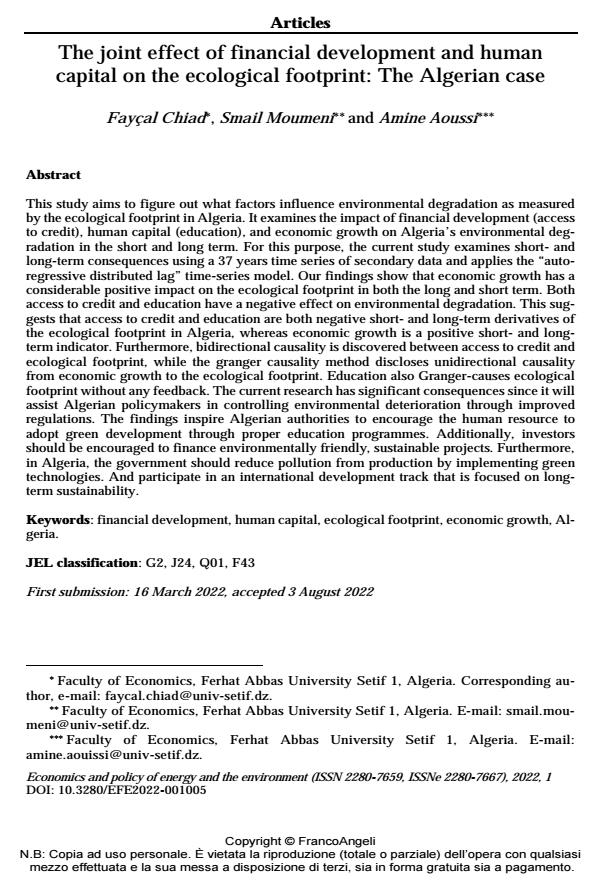The joint effect of financial development and human capital on the ecological footprint: The Algerian case
Titolo Rivista ECONOMICS AND POLICY OF ENERGY AND THE ENVIRONMENT
Autori/Curatori Fayçal Chiad, Smail Moumeni , Amine Aoussi
Anno di pubblicazione 2022 Fascicolo 2022/1
Lingua Inglese Numero pagine 25 P. 69-93 Dimensione file 306 KB
DOI 10.3280/EFE2022-001005
Il DOI è il codice a barre della proprietà intellettuale: per saperne di più
clicca qui
Qui sotto puoi vedere in anteprima la prima pagina di questo articolo.
Se questo articolo ti interessa, lo puoi acquistare (e scaricare in formato pdf) seguendo le facili indicazioni per acquistare il download credit. Acquista Download Credits per scaricare questo Articolo in formato PDF

FrancoAngeli è membro della Publishers International Linking Association, Inc (PILA)associazione indipendente e non profit per facilitare (attraverso i servizi tecnologici implementati da CrossRef.org) l’accesso degli studiosi ai contenuti digitali nelle pubblicazioni professionali e scientifiche
This study aims to figure out what factors influence environmental degradation as measured by the ecological footprint in Algeria. It examines the impact of financial development (access to credit), human capital (education), and economic growth on Algeria’s environmental deg- radation in the short and long term. For this purpose, the current study examines short- and long-term consequences using a 37 years time series of secondary data and applies the "autoregressive distributed lag" time-series model. Our findings show that economic growth has a considerable positive impact on the ecological footprint in both the long and short term. Both access to credit and education have a negative effect on environmental degradation. This sug- gests that access to credit and education are both negative short- and long-term derivatives of the ecological footprint in Algeria, whereas economic growth is a positive short- and long- term indicator. Furthermore, bidirectional causality is discovered between access to credit and ecological footprint, while the granger causality method discloses unidirectional causality from economic growth to the ecological footprint. Education also Granger-causes ecological footprint without any feedback. The current research has significant consequences since it will assist Algerian policymakers in controlling environmental deterioration through improved regulations. The findings inspire Algerian authorities to encourage the human resource to adopt green development through proper education programmes. Additionally, investors should be encouraged to finance environmentally friendly, sustainable projects. Furthermore, in Algeria, the government should reduce pollution from production by implementing green technologies. And participate in an international development track that is focused on longterm sustainability.
Parole chiave:financial development, human capital, ecological footprint, economic growth, Algeria.
Jel codes:G2, J24, Q01, F43
Fayçal Chiad, Smail Moumeni , Amine Aoussi, The joint effect of financial development and human capital on the ecological footprint: The Algerian case in "ECONOMICS AND POLICY OF ENERGY AND THE ENVIRONMENT" 1/2022, pp 69-93, DOI: 10.3280/EFE2022-001005